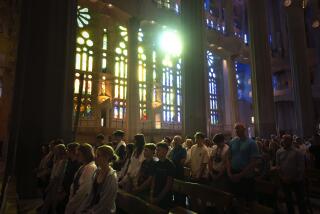Yugoslavia’s Serbian Christians Building Biggest Orthodox Cathedral in the World
- Share via
BELGRADE — Serbian Christians are building the biggest Orthodox cathedral in the world amid a resurgence of religion and nationalism in Yugoslavia.
On Vracar Mound at the edge of Belgrade, capital both of Yugoslavia and its biggest republic, Serbia, the cathedral is rising from the ashes of the church’s founder, St. Sava. His relics were burned by invading Ottoman Turks on this spot in 1595 in a bid to crush the Serbian spirit.
The project was conceived in 1895 on the tri-centenary of the desecration of St. Sava’s bones.
“It will be the world’s biggest practicing Orthodox church and biggest church of any faith in the Balkan region,” said Momir Lecic, secretary to Serbian Patriarch German.
“For modern times, the dimensions are tremendous,” Lecic said. “War interrupted the work many times but we got permission to resume it according to the original plans in 1985.”
Three years and $3 million in donations later, the outer shell, although still unadorned, is almost complete. It will be in Byzantine style with massive arches and cupolas.
The church estimates the final construction bill, excluding interior decoration, at about $15 million, and that building work will keep pace with the flow of donations.
Despite lean times amid 158% inflation and falling living standards, Serbs are giving generously, church sources said. Serb emigrants abroad also donate thousands of dollars.
“We give because this is our faith and our nation,” said Steve Enich, an American Serb involved in fund-raising.
The cathedral, which should be finished by 1992, will take up to 15,000 people and become the major shrine of Serbdom as well as a hallmark of the capital.
“This will be Belgrade’s main picture postcard,” a clergyman said.
Rising 250 feet from Vracar, it will dwarf the neighboring Serbian National Library. Its golden cross will look down on Belgrade’s tallest building, the Beogradjanka department store.
Inside, the church will be 307 feet long and 231 feet across. It will be 210 feet from the floor to the central cupola, to be covered in copper outside and mosaics inside.
The exterior is to have white and gray marble, the interior walls elaborate frescoes. It will provide a new church headquarters, a treasury of Serbian relics and a mausoleum for church leaders.
Cathedrals this big once took decades to build, but modern engineers have changed this. Between the world wars, the outer walls were begun with brick, slowly rising to more than 100 feet. In 1985, the new technique of concrete montage was adopted.
“The cupolas and arches are built on the ground and raised in place hydraulically. This is much faster than building them in position,” said Ljiliana Tanasijevic, one of the architects.
The central cupola, 108 feet across and weighing 4,000 tons, will be built on a platform 51 feet above ground and slowly hoisted into place over 15 days.
Yugoslavia is a communist but nonaligned state, with religious freedom guaranteed by the constitution.
But the church could not resume the Sava project while the country was led by Josip Broz Tito, who died in 1980 after 35 years of rule during which he firmly suppressed nationalism.
The 9 million Serbs are the biggest of Yugoslavia’s many nationalities. Racial and religious feuds fueled fratricidal conflicts through the region’s history.
Religion is now having a resurgence, especially among the young, coinciding with a fall in support for the ruling Communist Party.
In 1986, the Catholic and Orthodox churches were allowed for the first time to broadcast Christmas messages.
On Vracar Mound is a statue of Karadjordje, who led a first Serbian uprising against the Moslem Turks in the 16th Century. The cathedral will have a crypt in memory of Serbian Prince Lazar, killed in the 1389 Battle of Kosovo against the Turks.
“In these times, contributing to the cathedral can unite the Serbian nation,” a senior clergyman said.
“There are dioceses in America which don’t recognize our patriarch because we coexist with a Communist state. But even they support this project. Even Serbs who are Communists say, “Well, at least this is ours,’ ” he said.
More to Read
Sign up for Essential California
The most important California stories and recommendations in your inbox every morning.
You may occasionally receive promotional content from the Los Angeles Times.










